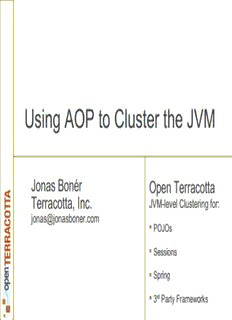
Using AOP to Cluster the JVM PDF
Preview Using AOP to Cluster the JVM
Using AOP to Cluster the JVM Jonas Bonér Open Terracotta Terracotta, Inc. JVM-level Clustering for: [email protected] POJOs Sessions Spring 3rd Party Frameworks Open Source Clustering for Java Goal of This Session Learn how JVM-level clustering and Open Terracotta works and is implemented Learn how JVM-level clustering provides a simpler environment for development without hindering scale-out Learn how AOP can be used to effectively modularize clustering and distributed computing in general by turning it into a runtime infrastructure service Let’s Start With A Demo Since a picture says more than a thousand words Shared Figure Editor Open Source Clustering for Java Agenda Introduction to Open Terracotta and JVM-level clustering Overview, architecture, features and benchmarks The inner workings of a clustered JVM JVM-level Clustering - the killer app for AOP? Challenges to address? How can it be done? Illustrated using AspectJ Why do we need JVM-level clustering? Problems with traditional clustering solutions How JVM-level clustering addresses these problems Open Source Clustering for Java What is clustering? People want clustering for… High-availability / Fail-over Scalability Coordination Traditional clustering solutions are Complex & expensive Intrusive Difficult to implement & manage Solutions are inconsistent ..and introduces code scattering and tangling Means that code is harder to write, test, understand, maintain and reuse Open Source Clustering for Java Open Terracotta: Open Source JVM-level Clustering Open Source under Mozilla-based license Feature overview Declarative configuration with minimal or no changes to existing application code No serialization - field-level replication Runtime lock optimizations Distributed thread coordination Virtual heap Open Source Clustering for Java Terracotta Approach Today's Reality Scale out is complex Requires custom java code Our approach is fundamentally different Cluster at the JVM Scale-out Development Benefits App Server App Server App Server Leverage Existing Infrastructure Substantially less code Web App Web App Web App Focus on business logic Business Logic Business Logic Business Logic Consistent Solution FrameworksCustSomerF irDaJaRmlMeieMzwvSoaIerktlsioopnmentFrameworks Operational Benefits Frameworks Frameworks Frameworks Scale Independently Consistent and Manageable Provides Increased Visibility nt ee JVM JVM JVM mol Ces Tgn ao Terracotta Server nC a Clustering the JVM M Open Source Clustering for Java Terracotta Use Cases HTTP Session Clustering Distributed Caching POJO Clustering - Spring Beans Collaboration / Coordination / Eventing Shared Memory / Large Virtual Memory Open Source Clustering for Java Terracotta Features Heap Level Replication Scale-out Declarative App Server App Server App Server No Serialization Fine Grained / Field Level Web App Web App Web App GET_FIELD Shared Shared Shared PUT_FIELD Objects Objects Objects Only Where Resident JVM Coordination JVM TC Libraries JVM TC Libraries JVM TC Libraries Distributed Synchronized Block Distributed Wait()/Notify() Fine Grained Locking Terracotta Server MONITOR_ENTER Clustering the JVM MONITOR_EXIT Large Virtual Heaps Configurable As large as available disk Dynamic paging Management Console Runtime visibility Data introspection Cluster monitoring Open Source Clustering for Java Terracotta Architecture Hub & Spoke Architecture HA Active / Passive Pair Scale-out Local JVM Client App Server App Server App Server Transparent Pure Java Libraries Web App Web App Web App Sessions Objects Sessions Objects Sessions Objects Terracotta Server 100% Pure Java Any Framework Any Framework Any Framework Central Storage Any Java Objects Any Java Objects Any Java Objects Maintains state across restarts Terracotta Library Terracotta Library Terracotta Library JVM JVM JVM Local JVM Client TerraTceortrtaac Soettrav eSre (rAvCerTIVE) CClluusstteerriinngg tthhee JJVVMM Terracotta Server Terracotta Server (PASSIVE) Clustering the JVM
Description: